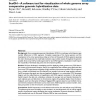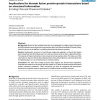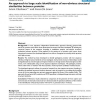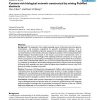BMCBI
2004
13 years 11 months ago
2004
BMCBI
2004
13 years 11 months ago
2004
Background: Array comparative genomic hybridization (CGH) is a technique which detects copy number differences in DNA segments. Complete sequencing of the human genome and the dev...
BMCBI
2004
13 years 11 months ago
2004
Background: Several in silico methods exist that were developed to predict protein interactions from the copious amount of genomic and proteomic data. One of these methods is Doma...
BMCBI
2004
13 years 11 months ago
2004
Background: We establish that the occurrence of protein folds among genomes can be accurately described with a Weibull function. Systems which exhibit Weibull character can be int...
BMCBI
2004
13 years 11 months ago
2004
Background: A new sequence independent bioinformatics approach allowing genome-wide search for proteins with similar three dimensional structures has been developed. By utilizing ...
BMCBI
2004
13 years 11 months ago
2004
Background: Using sequence-structure threading we have conducted structural characterization of complete proteomes of 37 archaeal, bacterial and eukaryotic organisms (including wo...
BMCBI
2004
13 years 11 months ago
2004
Background: G protein-coupled receptors (GPCRs) transduce signals from extracellular space into the cell, through their interaction with G proteins, which act as switches forming ...
BMCBI
2004
13 years 11 months ago
2004
Background: The prediction of ancestral protein sequences from multiple sequence alignments is useful for many bioinformatics analyses. Predicting ancestral sequences is not a sim...
BMCBI
2004
13 years 11 months ago
2004
BMCBI
2004
13 years 11 months ago
2004
Background: In a previous paper, we introduced MUSCLE, a new program for creating multiple alignments of protein sequences, giving a brief summary of the algorithm and showing MUS...




